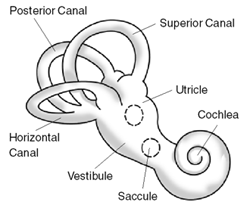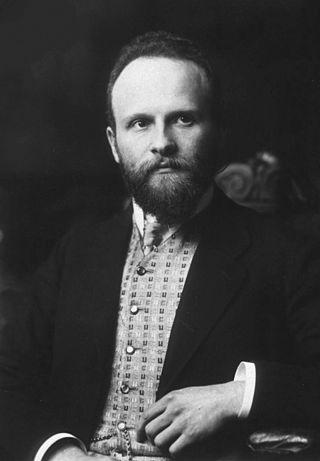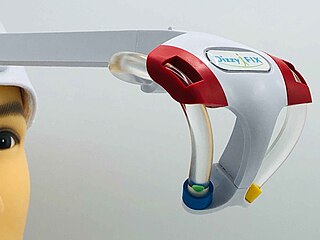
Ménière's disease (MD) is a disease of the inner ear that is characterized by potentially severe and incapacitating episodes of vertigo, tinnitus, hearing loss, and a feeling of fullness in the ear. Typically, only one ear is affected initially, but over time, both ears may become involved. Episodes generally last from 20 minutes to a few hours. The time between episodes varies. The hearing loss and ringing in the ears can become constant over time.
A balance disorder is a disturbance that causes an individual to feel unsteady, for example when standing or walking. It may be accompanied by feelings of giddiness, or wooziness, or having a sensation of movement, spinning, or floating. Balance is the result of several body systems working together: the visual system (eyes), vestibular system (ears) and proprioception. Degeneration or loss of function in any of these systems can lead to balance deficits.

Robert Bárány was an Austro-Hungarian otologist. He received the 1914 Nobel Prize in Physiology or Medicine for his work on the physiology and pathology of the vestibular apparatus.

The vestibular system, in vertebrates, is a sensory system that creates the sense of balance and spatial orientation for the purpose of coordinating movement with balance. Together with the cochlea, a part of the auditory system, it constitutes the labyrinth of the inner ear in most mammals.

Dizziness is an imprecise term that can refer to a sense of disorientation in space, vertigo, or lightheadedness. It can also refer to disequilibrium or a non-specific feeling, such as giddiness or foolishness.

Labyrinthitis is inflammation of the labyrinth, a maze of fluid-filled channels in the inner ear. Vestibular neuritis is inflammation of the vestibular nerve. Both conditions involve inflammation of the inner ear. Labyrinths that house the vestibular system sense changes in the head's position or the head's motion. Inflammation of these inner ear parts results in a vertigo and also possible hearing loss or tinnitus. It can occur as a single attack, a series of attacks, or a persistent condition that diminishes over three to six weeks. It may be associated with nausea, vomiting, and eye nystagmus.

Benign paroxysmal positional vertigo (BPPV) is a disorder arising from a problem in the inner ear. Symptoms are repeated, brief periods of vertigo with movement, characterized by a spinning sensation upon changes in the position of the head. This can occur with turning in bed or changing position. Each episode of vertigo typically lasts less than one minute. Nausea is commonly associated. BPPV is one of the most common causes of vertigo.

Electronystagmography (ENG) is a diagnostic test to record involuntary movements of the eye caused by a condition known as nystagmus. It can also be used to diagnose the cause of vertigo, dizziness or balance dysfunction by testing the vestibular system. Electronystagmography is used to assess voluntary and involuntary eye movements. It evaluates the cochlear nerve and the oculomotor nerve. The ENG can be used to determine the origin of various eye and ear disorders.

Vertigo is a condition in which a person has the sensation that they are moving, or that objects around them are moving, when they are not. Often it feels like a spinning or swaying movement. It may be associated with nausea, vomiting, perspiration, or difficulties walking. It is typically worse when the head is moved. Vertigo is the most common type of dizziness.

The vestibular nerve is one of the two branches of the vestibulocochlear nerve. In humans the vestibular nerve transmits sensory information from vestibular hair cells located in the two otolith organs and the three semicircular canals via the vestibular ganglion of Scarpa. Information from the otolith organs reflects gravity and linear accelerations of the head. Information from the semicircular canals reflects rotational movement of the head. Both are necessary for the sensation of body position and gaze stability in relation to a moving environment.
The Dix–Hallpike or Nylén–Bárány test is a diagnostic maneuver from the group of rotation tests used to identify benign paroxysmal positional vertigo (BPPV).

A labyrinthine fistula is an abnormal opening in the inner ear. This can result in leakage of the perilymph into the middle ear. This includes specifically a perilymph fistula (PLF), an abnormal connection between the fluid of the inner ear and the air-filled middle ear. This is caused by a rupture of the round window or oval window ligaments separating the inner and middle ear.

The DizzyFIX is a home medical device designed to assist in the treatment of benign paroxysmal positional vertigo (BPPV) and its associated vertigo. The device is a head-worn representation of semi-circular canals. The device is filled with fluid and a particle representing the otoconia associated with BPPV. The device works like a visual set of instructions and guides the user through the treatment maneuver for BPPV. This maneuver is called the particle repositioning maneuver or Epley maneuver.
The semicircular canal dehiscence (SCD) is a category of rare neurotological diseases/disorders affecting the inner ears, which gathers the superior SCD, lateral SCD and posterior SCD. These SCDs induce SCD syndromes (SCDSs), which define specific sets of hearing and balance symptoms. This entry mainly deals with the superior SCDS.
The Epley maneuver or repositioning maneuver is a maneuver used by medical professionals to treat one common cause of vertigo, benign paroxysmal positional vertigo (BPPV) of the posterior or anterior canals of the ear. The maneuver works by allowing free-floating particles, displaced otoconia, from the affected semicircular canal to be relocated by using gravity, back into the utricle, where they can no longer stimulate the cupula, therefore relieving the patient of bothersome vertigo. The maneuver was developed by the physician John M. Epley, and was first described in 1980.

Nystagmus is a condition of involuntary eye movement. People can be born with it but more commonly acquire it in infancy or later in life. In many cases it may result in reduced or limited vision.
Vestibular migraine (VM) is vertigo with migraine, either as a symptom of migraine or as a related neurological disorder.
The righting reflex, also known as the labyrinthine righting reflex, or the Cervico-collic reflex; is a reflex that corrects the orientation of the body when it is taken out of its normal upright position. It is initiated by the vestibular system, which detects that the body is not erect and causes the head to move back into position as the rest of the body follows. The perception of head movement involves the body sensing linear acceleration or the force of gravity through the otoliths, and angular acceleration through the semicircular canals. The reflex uses a combination of visual system inputs, vestibular inputs, and somatosensory inputs to make postural adjustments when the body becomes displaced from its normal vertical position. These inputs are used to create what is called an efference copy. This means that the brain makes comparisons in the cerebellum between expected posture and perceived posture, and corrects for the difference. The reflex takes 6 or 7 weeks to perfect, but can be affected by various types of balance disorders.
Benign paroxysmal vertigo of childhood is a neurological disorder that causes vertigo, a type of dizziness, in children. It is one of the most common causes of vertigo in children and is considered a subtype of migraine. BPVC is characterized by repeated, sudden episodes of vertigo that stop without intervention, typically lasting a few minutes. It is thought to occur due to a decrease in blood flow to the vestibular system, which regulates the body's balance and sense of position in space. These episodes do not require treatment and typically resolve by adolescence.

Vestibular rehabilitation (VR), also known as vestibular rehabilitation therapy (VRT), is a specialized form of physical therapy used to treat vestibular disorders or symptoms, characterized by dizziness, vertigo, imbalance, posture, and vision. These primary symptoms can result in secondary symptoms such as nausea, fatigue, and difficulty concentrating. Symptoms of vestibular dysfunction can significantly decrease quality of life, introducing mental-emotional issues such as anxiety and depression, and greatly impair an individual, causing them to become more sedentary. Decreased mobility can result in weaker muscles, less flexible joints, and worsened stamina, as well as decreased social and occupational activity. Vestibular rehabilitation therapy can be used in conjunction with cognitive behavioral therapy in order to reduce anxiety and depression resulting from a change in lifestyle.











